Bordeaux Uncovered: Must-See Streets of Bordeaux City.
Bordeaux, the gem of southwestern France, is a city steeped in history, culture, and a vibrant atmosphere. One of the best ways to experience the essence of Bordeaux is by walking through its charming streets. From medieval lanes to trendy avenues, each street tells a unique story of the city’s past and present. Here are the top 6 streets of Bordeaux that you must see when visiting this gorgeous city.
Rue Saint-James
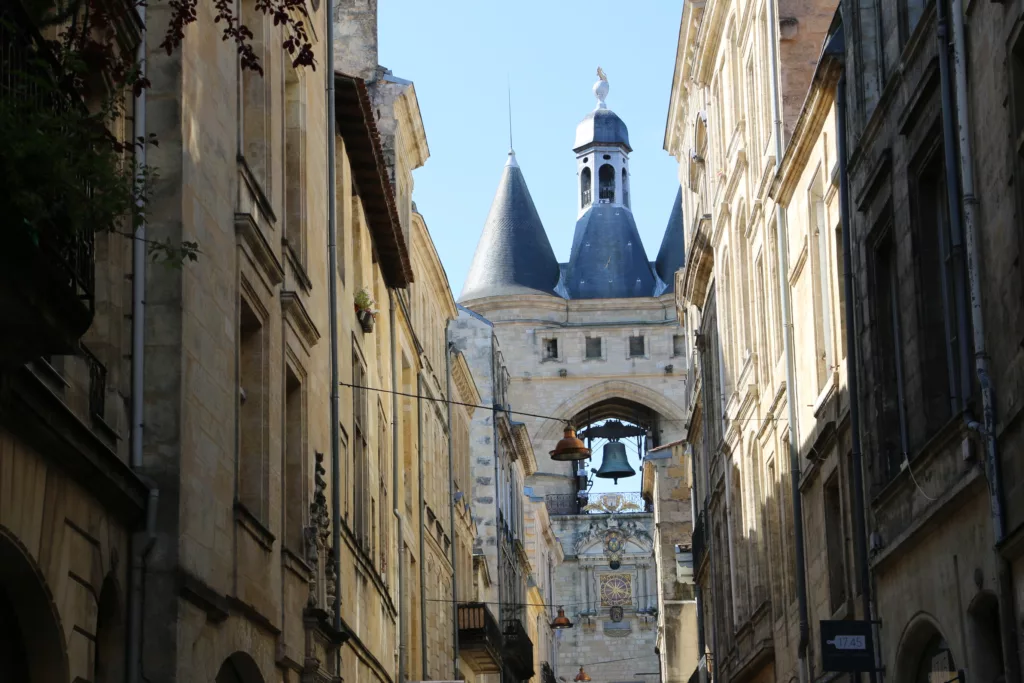
The history of Rue St James can be traced back to the Middle Ages when Bordeaux was a bustling port city with strong ties to the pilgrimage route to Santiago de Compostela in Spain. Pilgrims from all over Europe would pass through Bordeaux on their way to the holy site, seeking spiritual enlightenment and blessings.
During this time, Rue St James became an essential artery for these pilgrims as it offered a route through the city. As Bordeaux continued to grow and prosper, Rue St James evolved into a vibrant hub of commerce and culture. The street became lined with merchants’ houses, workshops, and artisanal shops. It catered not only to pilgrims but also to the local residents.
In the 18th century, Bordeaux experienced a period of economic prosperity and architectural renaissance, known as the Age of Enlightenment. During this time, Rue St James underwent further development and enhancement, with grand townhouses and mansions being built along its length.
Today, Rue St James retains much of its historic charm while also embracing modernity. The street is a lively mix of boutiques, cafes, and restaurants, attracting locals and visitors alike. Strolling down Rue St James, one can still feel echoes of its medieval past. With the old stone buildings whispering stories of pilgrims and merchants who once traversed its cobbled paths. Whether you’re admiring the architecture, shopping for unique treasures, or simply enjoying a coffee at one of its cafes Rue St James offers a glimpse into Bordeaux’s rich history and vibrant present.
Rue Notre Dame
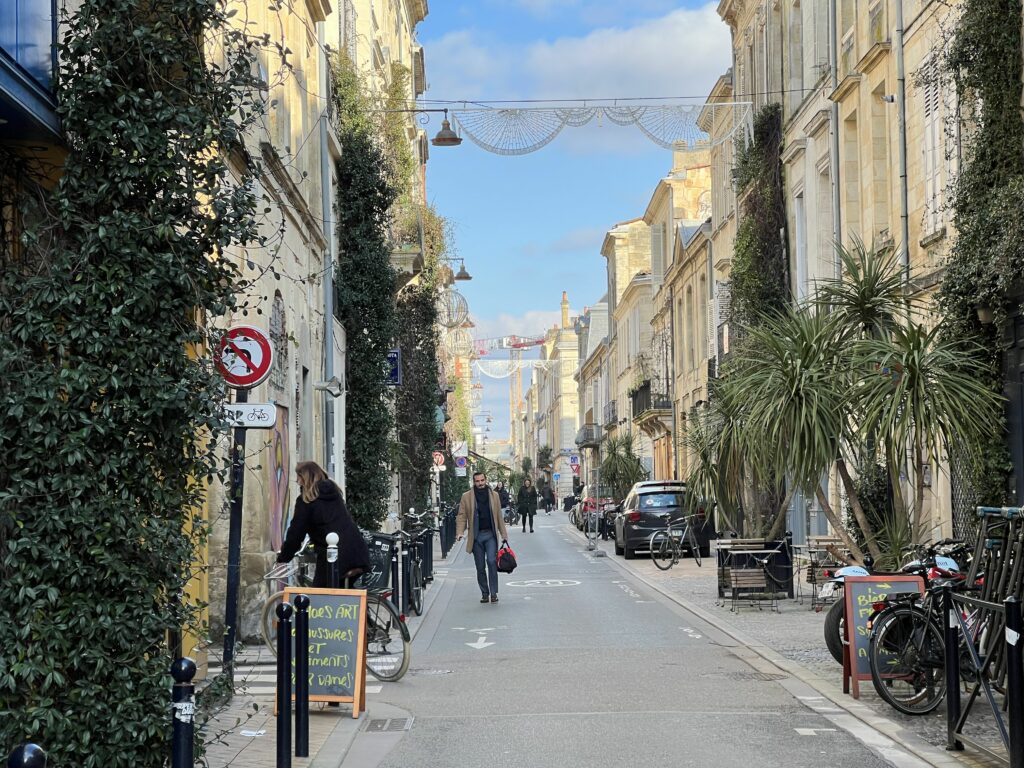
Rue Notre Dame in Chartrons, Bordeaux, is a street steeped in history, blending the city’s maritime past with its rich architectural heritage. This charming street is located in the Chartrons district, once a bustling hub of the wine trade and home to wealthy merchants and traders.
The history of Rue Notre Dame in Chartrons dates back to the 18th century when Bordeaux was at the height of its prosperity as a major port city. The Chartrons district was a crucial center for the wine trade, with merchants importing and exporting wine from all over the world.
The street itself was a bustling thoroughfare lined with grand townhouses, warehouses, and wine cellars. Merchants would display their wares in the storefronts, and the sound of horse-drawn carriages echoed along the cobbled streets. Rue Notre Dame was a hive of activity, with the sights and smells of the wine trade permeating the air.
As Bordeaux continued to prosper, the Chartrons district underwent further development and expansion. Many of the buildings along Rue Notre Dame were renovated or rebuilt in the neoclassical style that was popular at the time. The street became known for its elegant architecture, with ornate facades and wrought-iron balconies adorning the buildings.
During the 20th century, Bordeaux experienced a decline in its maritime trade, leading to changes in the Chartrons district. The wine trade shifted, and many of the warehouses along Rue Notre Dame were repurposed into art galleries, boutiques, and restaurants. The district began to attract artists and creatives, adding a new layer of vibrancy to the area.
Today, Rue Notre Dame in Chartrons is a charming blend of old and new. It retains much of its historic architecture, with elegant townhouses and former wine warehouses now housing stylish boutiques and galleries.
Rue du Pas-Saint Georges
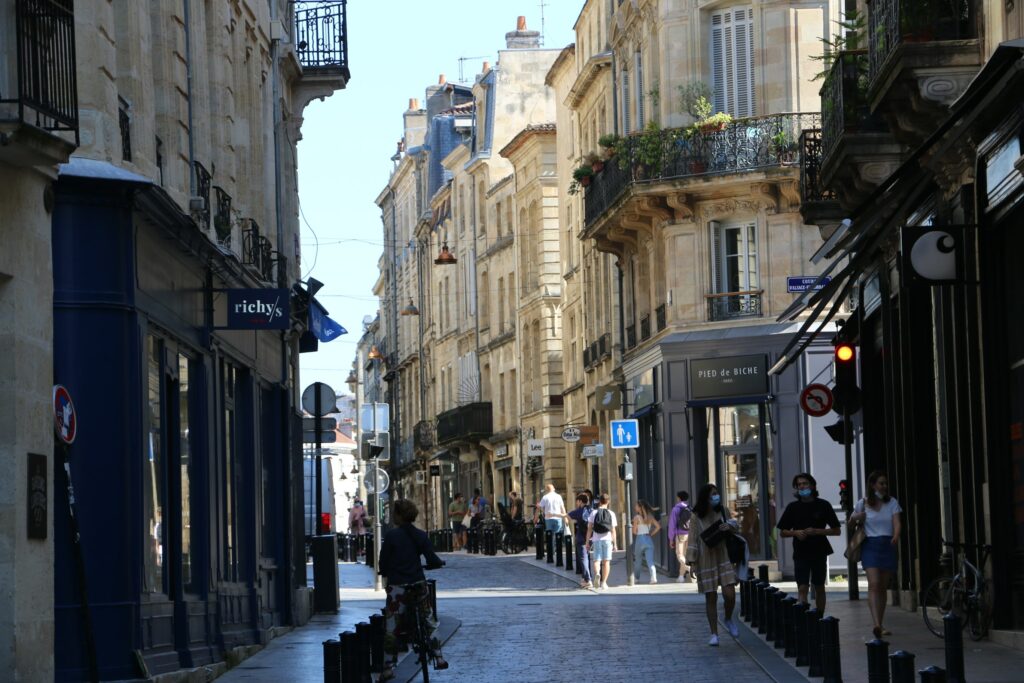
Rue du Pas-Saint George is unique in that it starts and ends at two famously beautiful squares as well as passing by another. Place Camille Jullian, Place du Parlement and Place Fernand Lafargue are known for their beautiful grandeur and bustling terraces, no matter the season.
Rue du Pas-Saint George is filled with numerous independent boutiques, from cheese to jewellery to fashion – excellent for an afternoon shopping in the old town of Bordeaux.
Rue Camille Sauvageau
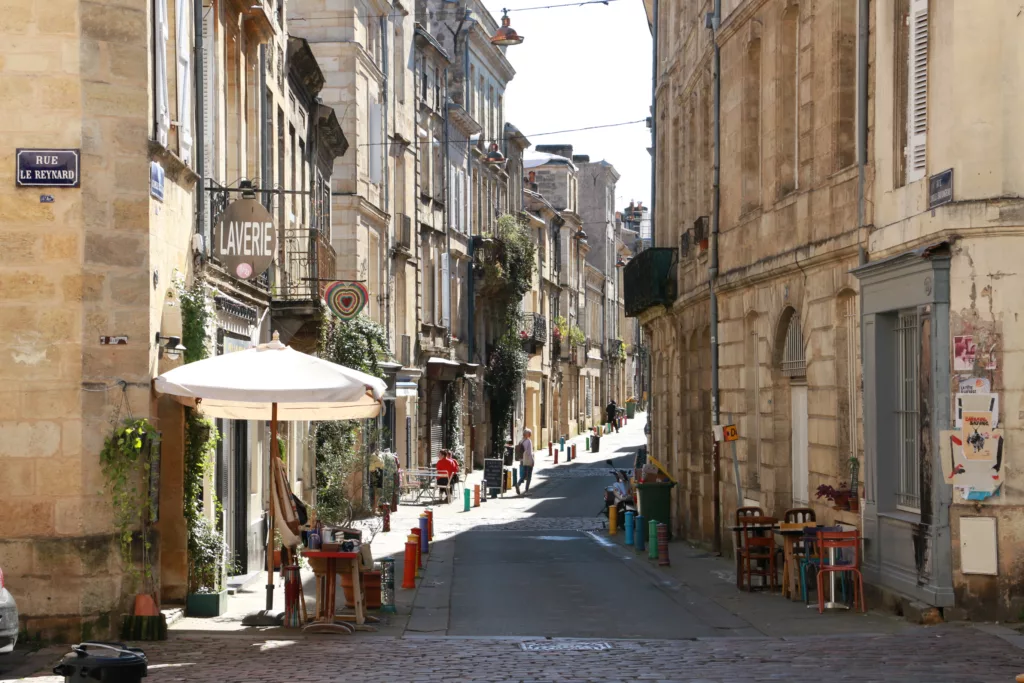
Camille Sauvageau was a doctor of science. He was an eminent botanist born in 1861 and appointed to Bordeaux in 1901. He held the chair of botany for thirty years and became a member of the institute in 1918.
Before being called Camille-Sauvageau, this street was called Sainte-Croix. Since the Middle Ages it ran from the abbey to the Saint-Michel district and was where wine merchants, boatmen and ship’s carpenters plied their trade.
Nowadays Rue Camille Sauvageau is dotted with little restaurants and bars, second hand shops and unique places to discover. Positioned a stone throw away from Place Canteloup which is home to some of the best markets of Bordeaux.
Rue du Loup
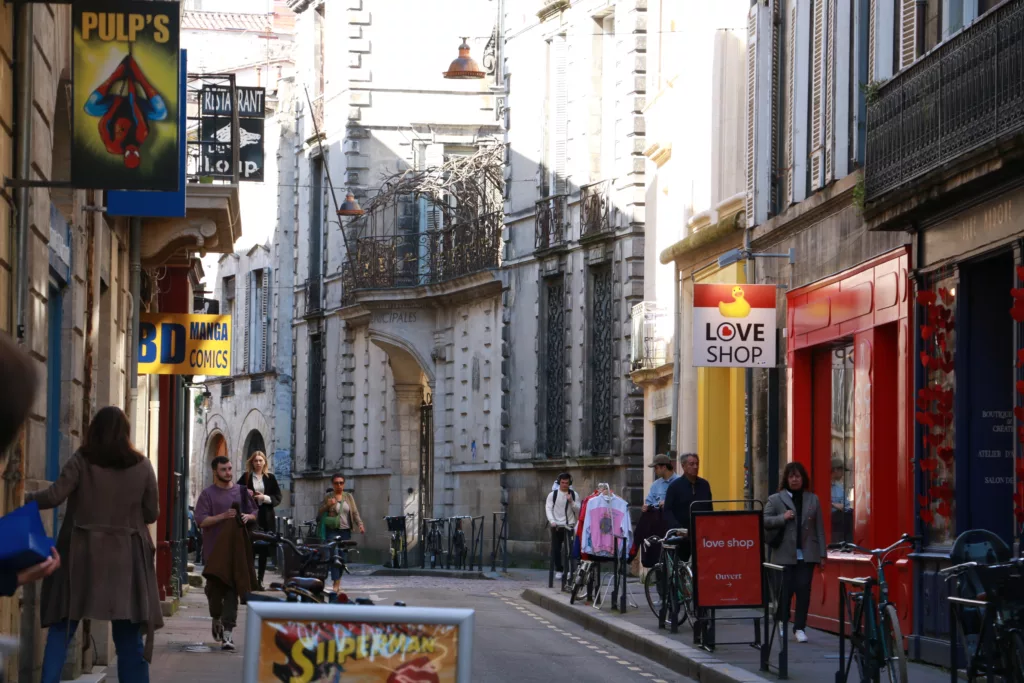
Situated in the heart of the old town, this street had a very commercial past during the Middle Ages which it has preserved. There are numerous stories about how Rue du Loup got its name. Some say that one of the traders allegedly displayed a wolf head as a sign for his shop. Therefore naturally it would have taken the name Rue du Loup, (Loup meaning wolf in French) as the storefront was so recognisable. Others say that in the 6th century wolves entered Bordeaux and invaded the streets known as the “attack of the wolves in Bordeaux.” However, there is little support for this theory for the name of Rue du Loup.
Rue du Loup is home to one of the most beautiful wisteria trees of Bordeaux. According to historians this plant came from China and was planted here around 1863. Since 2012 it has officially been labelled the “Remarkable Tree of France” for the work accomplished by the local council of Bordeaux by looking after, preserving and safe guarding it for all those years.
Rue des Faures
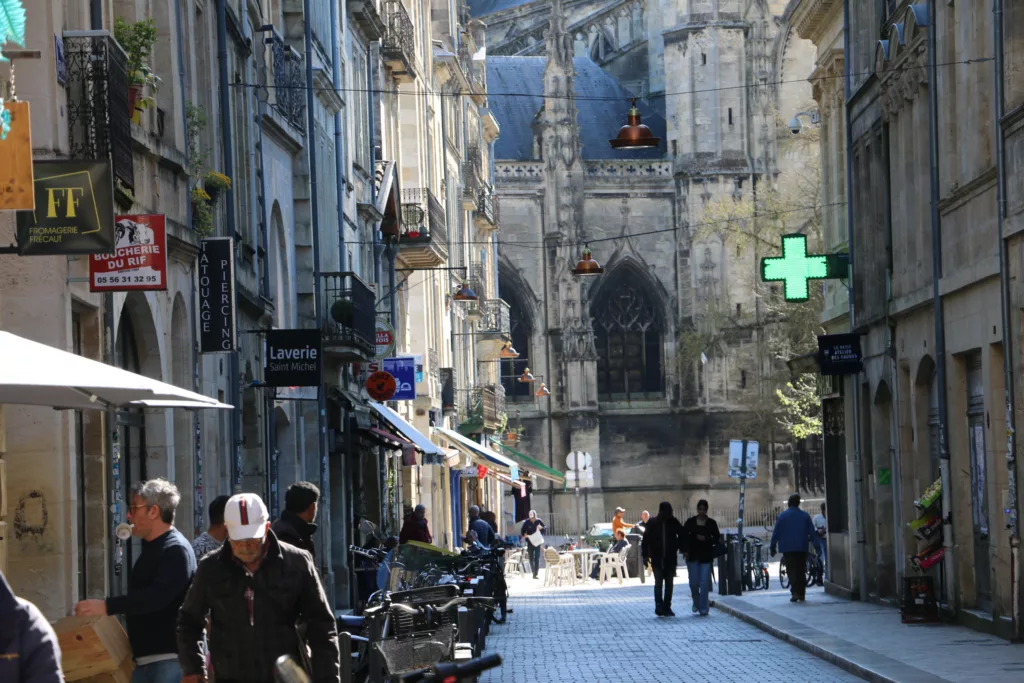
Rue des Faures, nestled in the historic St Michel district of Bordeaux, is a street with a fascinating history that spans centuries.
The history of Rue des Faures can be traced back to the Middle Ages when Bordeaux was a bustling port city and an important center of trade and commerce. The street gets its name from the “faures,” or blacksmiths, who once populated the area. In medieval times, Rue des Faures was home to numerous blacksmith workshops, where skilled craftsmen would forge tools, horseshoes, and other metal goods essential for the city’s economy.
As Bordeaux grew and prospered, so did Rue des Faures. The street became a vital artery in the St Michel district, connecting the bustling port along the Garonne River to the city’s commercial and residential areas. Merchants would travel along this street to sell their goods, and locals would gather to socialise and conduct business.
One of the notable landmarks along Rue des Faures is the Basilica of Saint Michel, located at the intersection of Rue des Faures and Place Canteloup. This impressive church dates back to the 14th century and is a striking example of Gothic architecture.
Today, Rue des Faures remains a vibrant and bustling street in the St Michel district of Bordeaux. As you wander down Rue des Faure which winds all the way down to the Garonne river, you can still feel the echoes of its medieval past and the legacy of the blacksmiths who once worked there.
About the bordelais
The bordelais is a private walking tour company in Bordeaux created by local Sophia. Her private tours focus on the historical city of Bordeaux. Each tour covers an in-depth narrative of the rich history of Bordeaux and how it impacts the modern day to day life of the Bordelais (locals of Bordeaux).
After years of living in the heart of Bordeaux city and going out alot, Sophia has discovered the best bars to dance the night away, the most delicious food and the quirky addresses you’d never discover without living here.
If you’d like to eat like a local during your time in Bordeaux, check out her downloadable food guide – www.foodtourclub.com
For more information on the tours Sophia offers.


